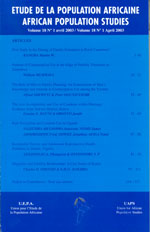
|
African Population Studies
Union for African Population Studies
ISSN: 0850-5780
Vol. 27, No. 2, 2013, pp. 203-215
|
 Bioline Code: ep13018
Bioline Code: ep13018
Full paper language: English
Document type: Research Article
Document available free of charge
|
|
|
African Population Studies, Vol. 27, No. 2, 2013, pp. 203-215
| en |
Effectiveness of using comic books to communicate HIV and AIDS messages to in-school youth: Insights from a pilot intervention study in Nairobi, Kenya
Obare, Francis; Birungi, Harriet; Deacon, Bridget & Burnet, Rob
Abstract
This paper uses data from a pilot pre- and post-intervention study that was conducted in eight secondary schools in Nairobi, Kenya, between 2010 and 2011 to examine the effectiveness of using comic books to deliver HIV and AIDS messages to in-school young people. Information was collected through structured self-administered interviews with 3,624 and 2,914 students at baseline and endline respectively. Qualitative feedback from students was also obtained through drop-boxes. The findings show that the comic books were effective in improving students’ knowledge about modes of infection, enhancing communication about the epidemic among them, positively changing their attitudes towards people living with HIV, reducing their fear and increasing their likelihood and intention of getting tested for HIV, as well as positively changing their sexual behaviours. The study underscores the need for age-appropriate communications channels to reach young people with HIV and AIDS information in settings that are affected by the epidemic.
Keywords
HIV and AIDS; communication; comic books; in-school young people; Kenya
|
| |
| fr |
Obare, Francis; Birungi, Harriet; Deacon, Bridget & Burnet, Rob
Résumé
Cet article utilise des données provenant d'une étude pilote pré-et post-intervention qui a été menée dans huit écoles secondaires à Nairobi, au Kenya, entre 2010 et 2011 pour examiner l'efficacité de l'utilisation des bandes dessinées pour offrir les messages sur le VIH et le SIDA aux jeunes scolarisés. Des informations ont été recueillies par des interviews structurés auto-administrés avec 3.624 et 2.914 étudiants au départ et fin d'étude, respectivement. La rétroaction qualitative des étudiants a également été obtenu grâce aux boîtes de dépôt. Les résultats montrent que les bandes dessinées ont permis d'améliorer les connaissances des élèves sur les modes d'infection, l'amélioration de la communication sur l'épidémie parmi eux, modifier positivement leurs attitudes envers les personnes vivant avec le VIH, de réduire leur peur et d'augmenter leur probabilité et leur intention de se faire tester pour VIH, ainsi que modifier positivement leurs comportements sexuels. L'étude souligne la nécessité des canaux de communication adaptés à l'âge pour atteindre les jeunes avec le VIH et le SIDA dans les milieux qui sont touchés par l'épidémie.
|
| |
© African Population Studies
Alternative site location: http://www.uaps-uepa.org
|
|
